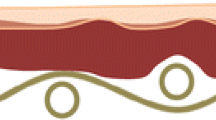Abstract
One of the main problems connected to the conservation of street art is the selective removal of overlying undesired graffiti, i.e., drawings and tags. Unfortunately, selective and controlled removal of graffiti and overpaintings from street art is almost unachievable using traditional methodologies. Recently, the use of nanofluids confined in highly retentive pHEMA/PVP semi-interpenetrated polymer networks was proposed. Here, we report on the selective removal of acrylic overpaintings from a layer of acrylic paint on mortar mockups in laboratory tests. The results of the cleaning tests were characterized by visual and photographic observation, optical microscopy, and FT-IR microreflectance investigation. It was shown that this methodology represents a major advancement with respect to the use of nonconfined neat solvents.


Similar content being viewed by others
References
Sanmartín P, Cappitelli F, Mitchell R. Current methods of graffiti removal: a review. Constr Build Mater. 2014;71:363–74. doi:10.1016/j.conbuildmat.2014.08.093.
Whitford MJ (1992) Getting rid of graffiti: a practical guide to graffiti removal and anti-graffiti protection. Taylor & Francis
Pozo-Antonio JS, Ramil A, Fiorucci MP, López AJ, Rivas T. The use of hyperspectral imaging technique to detect the most suitable graffiti-cleaning procedure. Color Res Appl. 2016;41:308–12. doi:10.1002/col.22032.
Pozo-Antonio JS, Rivas T, López AJ, Fiorucci MP, Ramil A. Effectiveness of granite cleaning procedures in cultural heritage: a review. Sci Total Environ. 2016;571:1017–28. doi:10.1016/j.scitotenv.2016.07.090.
Pozo-Antonio JS, Rivas T, Fiorucci MP, López AJ, Ramil A. Effectiveness and harmfulness evaluation of graffiti cleaning by mechanical, chemical and laser procedures on granite. Microchem J. 2016;125:1–9. doi:10.1016/j.microc.2015.10.040.
Chapman S. Laser technology for graffiti removal. J Cult Herit. 2000;1(Supplement 1):S75–8. doi:10.1016/S1296-2074(00)00153-9.
Carvalhão M, Dionísio A. Evaluation of mechanical soft-abrasive blasting and chemical cleaning methods on alkyd-paint graffiti made on calcareous stones. J Cult Herit. 2015;16:579–90. doi:10.1016/j.culher.2014.10.004.
Siano S, Osticioli I, Pavia A, Ciofini D. Overpaint removal from easel paintings using an LQS Nd:YAG laser: the first validation study. Stud Conserv. 2015;60:S49–57. doi:10.1179/0039363015Z.000000000207.
Apostol I, Damian V, Garoi F, Iordache I, Bojan M, Apostol D, Armaselu A, Morais PJ, Postolache D, Darida I. Controlled removal of overpainting and painting layers under the action of UV laser radiation. Opt Spectrosc. 2011;111:287. doi:10.1134/S0030400X11080054.
Ciofini D, Osticioli I, Pavia A, Siano S. Removal of overpaintings from easel paintings using LQS Nd:YAG laser. Appl Phys A Mater Sci Process. 2014;117:341–6. doi:10.1007/s00339-014-8318-2.
Baglioni P, Berti D, Bonini M, Carretti E, Dei L, Fratini E, Giorgi R. Micelle, microemulsions, and gels for the conservation of cultural heritage. Adv Colloid Interf Sci. 2014;205:361–71. doi:10.1016/j.cis.2013.09.008.
Pizzorusso G, Fratini E, Eiblmeier J, Giorgi R, Chelazzi D, Chevalier A, Baglioni P. Physicochemical characterization of acrylamide/bisacrylamide hydrogels and their application for the conservation of easel paintings. Langmuir. 2012;28:3952–61. doi:10.1021/la2044619.
Baglioni M, Bartoletti A, Bozec L, Chelazzi D, Giorgi R, Odlyha M, Pianorsi D, Poggi G, Baglioni P. Nanomaterials for the cleaning and pH adjustment of vegetable-tanned leather. Appl Phys A Mater Sci Process. 2016;122:114. doi:10.1007/s00339-015-9553-x.
Baglioni P, Chelazzi D. Nanoscience for the conservation of works of art: Royal Society of Chemistry; 2013.
Bonelli N, Chelazzi D, Baglioni M, Giorgi R, Baglioni P. Confined aqueous media for the cleaning of cultural heritage: innovative gels and amphiphile-based nanofluids. In: Dillmann P, Bellot-Gurlet L, Nenner I, editors. Nanosci. Cult: Herit. Atlantis Press; 2016. p. 283–311.
Domingues JAL, Bonelli N, Giorgi R, Fratini E, Gorel F, Baglioni P. Innovative hydrogels based on semi-interpenetrating p(HEMA)/PVP networks for the cleaning of water-sensitive cultural heritage artifacts. Langmuir. 2013;29:2746–55. doi:10.1021/la3048664.
Giorgi R, Baglioni M, Berti D, Baglioni P. New methodologies for the conservation of cultural heritage: micellar solutions, microemulsions, and hydroxide nanoparticles. Acc Chem Res. 2010;43:695–704. doi:10.1021/ar900193h.
Baglioni M, Rengstl D, Berti D, Bonini M, Giorgi R, Baglioni P. Removal of acrylic coatings from works of art by means of nanofluids: understanding the mechanism at the nanoscale. Nano. 2010;2:1723. doi:10.1039/c0nr00255k.
Baglioni M, Berti D, Teixeira J, Giorgi R, Baglioni P. Nanostructured surfactant-based systems for the removal of polymers from wall paintings: a small-angle neutron scattering study. Langmuir. 2012;28:15193–202. doi:10.1021/la303463m.
Domingues J, Bonelli N, Giorgi R, Baglioni P. Chemical semi-IPN hydrogels for the removal of adhesives from canvas paintings. Appl Phys A Mater Sci Process. 2013;114:705–10. doi:10.1007/s00339-013-8150-0.
Domingues J, Bonelli N, Giorgi R, Fratini E, Baglioni P. Innovative method for the cleaning of watersensitive artifacts: synthesis and application of highly retentive chemical hydrogels. Int J Conserv Sci. 2013;4:715–22.
Acknowledgements
Margherita Alterini is acknowledged for the assistance with laboratory tests on removal of overpaintings from modern paints laid on mortar samples. Yvonne Shashoua and Isabelle Brajer are kindly acknowledged for fruitful discussion about this topic and for providing us with useful information about this new conservative issue. CSGI is acknowledged for partly funding this work, which was otherwise supported by the European Union (CORDIS)-Project NANORESTART (H2020-NMP-21-2014/646063).
Author information
Authors and Affiliations
Corresponding author
Ethics declarations
Conflict of interest
The authors declare that they have no conflict of interests.
Additional information
No kinship exists between Michele Baglioni and Piero Baglioni.
Rights and permissions
About this article
Cite this article
Giorgi, R., Baglioni, M. & Baglioni, P. Nanofluids and chemical highly retentive hydrogels for controlled and selective removal of overpaintings and undesired graffiti from street art. Anal Bioanal Chem 409, 3707–3712 (2017). https://doi.org/10.1007/s00216-017-0357-z
Received:
Revised:
Accepted:
Published:
Issue Date:
DOI: https://doi.org/10.1007/s00216-017-0357-z




